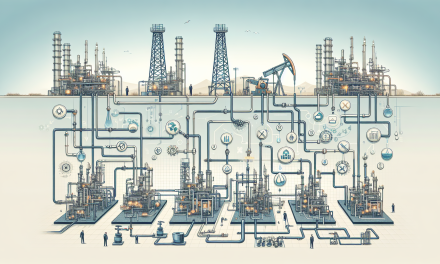Table of Contents
- 1. Introduction
- 2. Understanding Petroleum Refining
- 3. The Importance of Production Planning
- 4. Scheduling in Refining
- 5. Yield Optimization Techniques
- 6. Advanced Strategies for Yield Optimization
- 7. Frequently Asked Questions
- 8. Conclusion
1. Introduction
Petroleum refining plays a crucial role in converting crude oil into valuable products that we use every day, such as gasoline, diesel, and jet fuel. With the increasing complexity of market demands and the need for operational efficiency, production planning, scheduling, and yield optimization have become central aspects of the refining process. In this blog post, we will explore these critical areas in-depth, providing insights that can help improve performance in petroleum refining.
2. Understanding Petroleum Refining
Before delving into the nitty-gritty of production planning and yield optimization, it’s essential to understand the petroleum refining process. Refining involves breaking down crude oil into its components and then reassembling these components into usable products. This process includes various stages such as distillation, conversion, and treatment.
2.1 Distillation
During distillation, crude oil is heated in a distillation column. As it heats up, different components rise through the column and condense at various levels based on their boiling points. This process results in fractions such as naphtha, kerosene, and heavier oils.
2.2 Conversion
Next, conversion refers to processes like cracking and reforming, where larger hydrocarbon molecules are broken into smaller ones. This step enhances the yield of desired products, particularly when targeting specific market demands.
2.3 Treatment
Finally, treatment processes remove impurities from the refined products to meet quality standards. This includes processes like hydro treating and desulfurization, which ensure that the products are safe and environmentally friendly.
3. The Importance of Production Planning
Effective production planning in refinery operations can significantly impact profitability. It involves forecasting demand, understanding production capabilities, and coordinating resources efficiently.
3.1 Demand Forecasting
Accurate demand forecasting helps refineries align their production with market needs. By employing data analytics and industry trends, refineries can produce the right amount of product, thus minimizing waste and excess inventory.
3.2 Resource Allocation
Furthermore, proper resource allocation ensures that facilities operate at optimal capacity. Each production unit requires specific equipment and personnel, and planning helps streamline these resources effectively.
4. Scheduling in Refining
Scheduling is the process of organizing production activities to maximize efficiency while meeting demand. It requires a careful balance of various factors, including time, resources, and operational constraints.
4.1 Effective Scheduling Techniques
Utilizing advanced scheduling techniques can significantly boost refinery operations. Methods like just-in-time (JIT) scheduling reduce inventory costs while improving workflow efficiency. Additionally, employing software solutions to automate scheduling can lead to better visibility and adaptability.
4.2 Impact on Operations
Moreover, effective scheduling improves safety and minimizes downtime. By forecasting maintenance needs and scheduling around them, refineries can operate more smoothly and safely.
5. Yield Optimization Techniques
Yield optimization focuses on maximizing the output of valuable products from the refining process. By adopting a multifaceted approach, refineries can enhance their efficiency and profitability.
5.1 Process Improvement
Continuous improvement in refining processes is vital. Techniques like lean manufacturing help identify waste and inefficiencies, allowing for streamlined operations. In addition, investing in modern technology can lead to significant breakthroughs in yield.
5.2 Feedstock Management
Effective feedstock management also contributes to yield optimization. Understanding the properties of various crude oils enables refineries to select the most appropriate feedstock for specific processes, thereby improving overall yield.
5.2.1 Analyzing Crude Oil Quality
By analyzing the quality of incoming crude oil, refineries can optimize their processing parameters. For instance, certain chemicals may be added during processing to enhance yield based on the specific characteristics of the feedstock.
5.2.2 Blending Strategies
Additionally, blending strategies can enhance yields. By carefully mixing different grades of crude oil, refineries can optimize their output and meet specific product specifications more effectively.
6. Advanced Strategies for Yield Optimization
Advanced strategies involve leveraging technology and innovative practices to take yield optimization to new heights.
6.1 Data Analytics and AI
Implementing data analytics and artificial intelligence into refining operations allows for better decision-making concerning production and scheduling. These technologies can predict trends and identify patterns in operational data, making it easier to optimize processes.
6.2 Process Simulation Software
Moreover, using process simulation software can help refiners visualize operations and conduct scenario analysis. This allows for the identification of bottlenecks and the testing of potential changes before implementing them in real-world conditions.
6.3 Continuous Training and Development
It’s also important to invest in continuous training for staff. Staying updated on the latest technologies and methodologies is vital for maintaining a competitive edge. For a structured approach to training, consider exploring the Petroleum Production Planning, Scheduling & Yield Optimization Course, which can provide valuable insights and skills for practitioners in the field.
7. Frequently Asked Questions
7.1 What role does technology play in petroleum refining?
Technology is essential in streamlining processes, improving data analysis, automation in scheduling, and enhancing overall operational efficiency within the refining industry.
7.2 How can refineries reduce waste and improve yield?
Refineries can reduce waste by analyzing operations to identify inefficiencies and adopting lean methodologies. Additionally, optimizing feedstock management and investing in improved processing technologies can enhance yield.
8. Conclusion
In conclusion, mastering petroleum refining involves a thorough understanding of production planning, scheduling, and yield optimization. Effectively managing these elements can lead to improved efficiency and profitability. As the industry continues to evolve, embracing new technologies and methodologies will be crucial for long-term success. For those looking to deepen their knowledge and skills in the petroleum industry, refer to these resources: Mini Master in the Petroleum Industry, Ultimate A-Z Guide to Mastering the Petroleum Industry, Comprehensive Guide to Process Plant Equipment Integrity, Fundamentals of Process Technology, and Secrets of Reinforced Concrete Structural Design. Investing in your knowledge is investing in your success in the dynamic petroleum refining sector.





